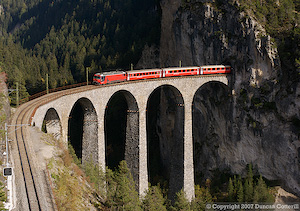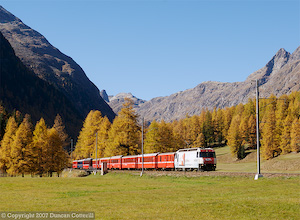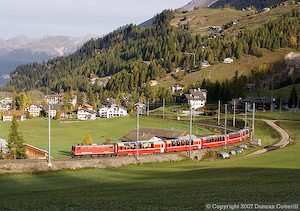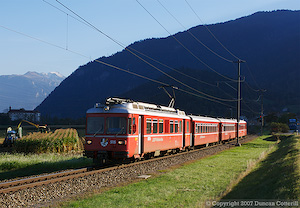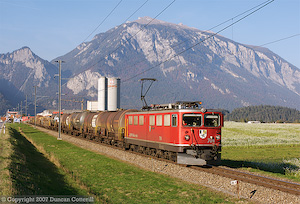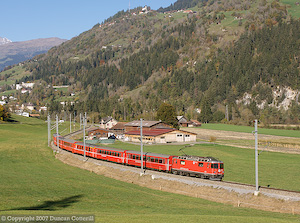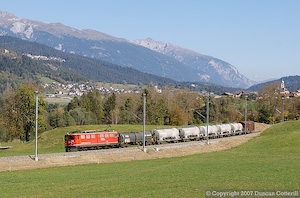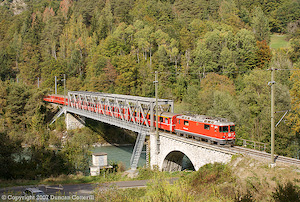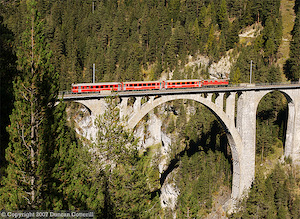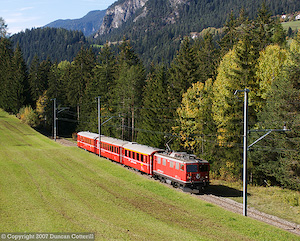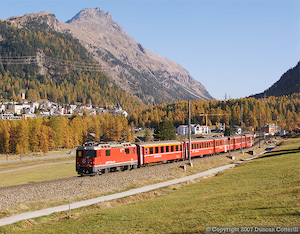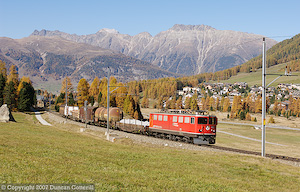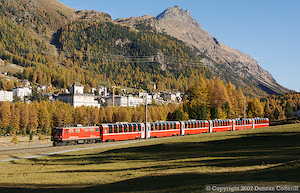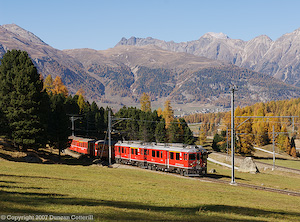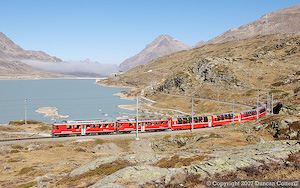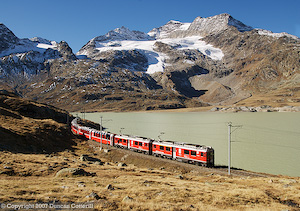A Week on the Rhätischebahn
07 - 14 October 2007
Report by Duncan Cotterill
Introduction
The Rhätischebahn operates an extensive meter gauge electified network in the canton of Graubunden in south-eastern Switzerland. Its lines link the regional capital Chur with the alpine resorts of Klosters, Davos and St Moritz, passing through some of the finest alpine scenery en-route. There are no rack sections and the system is main-line in character with loco hauled passenger trains and a surprising amount of freight traffic. This is one of Europe's most scenic and photogenic railways but seems to get very little coverage on the web. I visited the Rhätischebahn for a week between 7 and 14 October 2007.
The Albula Line
This is the Rhätischebahn's principal main line and links Chur with St Moritz. The line climbs up the valleys of the Rhein, Hinterrhein and Albula rivers via Reichenau-Tamins, Thusis, Filisur and Bergün, crossing the famous Landwasser viaduct and negotiating a series of spirals to gain height. The summit is 1823m above sea level in the 5.8km Albula Tunnel that gives access to the Engadin. Needless to say, it's a spectacularly scenic railway.
Passenger Trains
There are hourly passenger trains between Chur and St Moritz, calling at principal stations. These are loco hauled, usually by the RhB's most modern locomotives, the Ge4/4IIIs dating from 1993. These engines are all painted in advertising liveries that range from "quite pleasant" to "pass the sick bag". As you can probably tell, I'm not a great fan of these Werbeloks. When a Ge4/4III isn't available one of the older Ge6/6II locos often fills in. This happened on three days during my visit. Ge4/4IIIs 643, 644, 649, 650, 651, 652 were regular performers with Ge6/6IIs 702 and 703 filling in.
Two local passenger services operate at the Chur end of the line. One calls at all stations between Chur and Thusis where it connects with the Chur - St Moritz service. The other starts at Schiers, on the Landquart - Klosters line and runs through Landquart and Chur to Rhäzüns, between Reichenau-Tamins and Thusis. These services are operated by class Be4/4 motor coaches paired with short push-pull rakes. Be4/4s 511, 512, 514, 515, 516 were all seen on these trains.
Tourist Trains
In addition to the trains for normal passengers, the RhB runs a number of services aimed at tourists. These are usually operated with panoramic coaches, attract a modest supplement and have compulsory reservations. Several trains run in multiple sections. During my visit, Glacier Express services were running between Chur and St Moritz as portions of the normal RegioExpress trains. These provide the rare opportunity to travel on a train that has different departure times and stopping patterns depending on which coach you travel in.
Other tourist services operate over the Albula line as follows: The Chur - Davos section of the Glacier Express was always worked by a Ge4/4I as was the Davos - Pontresina section of the Bernina Express. Both these trains run via Filisur. The Chur - Pontresina section of the Bernina Express was usually a Ge4/4II. Locos seen included Ge4/4Is 603, 604, 610 and Ge4/4IIs 613, 621, 623, 628. Locos 603 and 604 were regulars and appeared on the Davos trains almost every day.
Freight Trains
Freight traffic over the Albula line seems remarkably heavy until you see the terrain between Thusis and Bever and then you wonder why anyone would even think of transporting goods to the Engadin by road. A typical weekday would see 4 or 5 freights each way over the Albula in daylight with the vast majority hauled by class Ge6/6II locos. Class Ge4/4Is also appeared on occasions, particularly on the 13:30 Samedan - Landquart freight. There was virtually no freight at weekends. Ge4/4Is 601, 605, 609 and Ge6/6IIs 701, 703, 704, 705, 706, 707 were all seen on Albula line freights.
Photography
The Albula line is truly spectacular. There are more viaducts, tunnels, spirals, waterfalls, rivers and mountains than on any other line I can think of. However, like many mountain lines, most potential photographs are impossible to get unless you can hover 50 feet off the ground or have a magic camera that can see through trees. There are some excellent locations though and the comprehensive and well-signed network of footpaths that radiates from most stations makes access to most spots relatively straightforward.
As mentioned above, I don't like locos in advertising liveries but there were enough freights and tourist trains on the Albula line on weekdays to ensure you could get a well lit shot at almost any location with a nice red engine hauling the train.
The Disentis Line
This line leaves the Albula route at Reichenau-Tamins and follows the Vorderrhein valley west to Disentis/Muster where it makes an end on connection with the former Furka-Oberalp (now Matterhorn Gotthard Bahn) meter gauge line to Andermatt and Brig.
Passenger Trains
The Disentis line is also served by an hourly loco hauled passenger service from Chur with the majority of services starting back at either Scuol-Tarasp or Landquart. Most trains were worked by class Ge4/4IIs while I was there but RE1220 and RE1245 were hauled by Ge6/6II 706 on 08/10/07. Ge4/4IIs 612, 613, 615, 616, 619, 620, 621, 623, 624,625, 631 were all seen on Disentis line passengers.
Tourist Trains
Two Glacier Express services operated over the line during my visit. One train was formed of a Chur - Zermatt and a St Moritz - Zermatt portion and the other of a second St Moritz - Zermatt portion paired with the Davos - Zermatt section. Similar pairings occurred in the reverse direction. Ge4/4IIs 614, 621, 625 were seen on these trains.
Freight Trains
On weekdays there are several freight workings on the Disentis line but many only run as far as Ilanz. On 08/10/07, I spent seven hours on the line and saw six freights east of Ilanz, three in each direction. Ge4/4IIs 611, 616, 631 and Ge6/6IIs 705, 707 all appreared on Disentis line freights during my visit. Ge4/4II 611 was in a hideous advertising livery from the "pass the sick bag" end of the spectrum. In fact it looked as if the sick bag hadn't been passed in time and the loco had received the full discharge.
Photography
I didn't go beyond Ilanz so can't comment on the photographic potential at the Disentis end of the line. The first 15km from Reichenau-Tamins, through the Vorderrhein gorge, are spectacular but look pretty inaccessible.
The Filisur - Davos Line
This line leaves the Albula route at Filisur and climbs up the valley of the Landwasser river to the resort of Davos. At the Filisur end, the river is in a deep gorge and the line features many tunnels and a spectacular (I seem to be using that word a lot) bridge at Wiesen. Beyond Davos the line continues to Landquart via Klosters.
Passenger Trains
The current passenger service consists of an hourly push-pull shuttle from Filisur to Davos and back. These trains connect with Albula line trains at Filisur but are 30 minutes out of phase with the Landquart - Klosters - Davos services at the other end. A single push-pull set powered by a class Ge4/4I covers the whole day's service except for a couple of very early and very late trains. Ge4/4Is 606, 607, 608 were seen on these trains during my visit. The loco was at the Davos end every time.
Tourist Trains
The Davos portions of the Glacier Express and Bernina Express use this line and are also worked by Ge4/4Is . These workings are discussed in the section on the Albula line.
Freight Trains
There are a couple of conditional paths for freights but I didn't see anything run during my visit.
The Pontresina - Scuol-Tarasp Line
This line serves a long stretch of the Engadin, the valley of the River En, which becomes the River Inn when it enters Austria. Pontresina lies in the Upper Engadin, at the foot of the Bernina Pass (of which more later) and close to St Moritz. The line descends to Samedan where it meets the route from St Moritz and both routes share a single track from there to Bever where the Albula line turns to the west and heads for the Albula Tunnel. The Scuol line continues to head north-east along the broad valley to S-Chanf where river and railway begin the steep descent into the Lower Engadin. The valley narrows and green meadows give way to forests and steep hillsides, changing briefly to meadows again around Zernez before the descent continues. At Sagliains, the line through the new Vereina Tunnel comes in from the north-west and joins the line to Scuol. The junction and the terminal for the car shuttles to Selfranga, near Klosters are squeezed onto a narrow ledge on the steep hillside. For the remainder of the route the line continues to cling to the steep hillsides on the north side of the valley, with a couple of long tunnels bypassing difficult areas. It terminates at a station high above the vilage of Scuol. At one time it was planned to extend the line to Landeck in Austria but the extension was never built.
Passenger Trains
Like most Rhätischebahn lines, the route from Pontresina to Scuol-Tarasp enjoys an hourly passenger service for most of the day. During my visit, trains were worked in push-pull mode and most were powered by class Ge4/4II locos at the Scuol-Tarasp end of the formation. Ge4/4Is also appeared on a few services, particularly in the early morning. Ge4/4II 618, 626, 627 appeared to be the regular power for these trains. Ge4/4I 602 worked R1917 on the four mornings that I saw it.
East of Sagliains the Landquart - Klosters - Scuol Tarasp service shares the route with the Pontresina trains with the services connecting at Sagliains. Many of these services run through from the Disentis line. See the Disentis section for locos.
Tourist Trains
The Chur - Tirano and Davos - Tirano trains use the route between Bever and Pontresina and are covered in the Albula line section. Another train, branded the "Engadin Star", operates Landquart - Klosters - Sagliains - Samedan - St Moritz but runs as a normal RegioExpress service, without supplement or compulsory reservations, rather than as a dedicated tourist train.
Freight
The line sees a number of freight workings, mainly Landquart - Pontresina trains that use the line between Bever and Pontresina that have been described in the Albula line section. There is also a morning freight from Samedan to Scuol Tarasp that then returns as far as Zernez. It was worked by Ge6/6II 704 on the only occasion that I saw it.
Photography
The Upper Engadin is fairly open with plenty of reasonable photo locations from Pontresina to S-Chanf. Further east it looks pretty difficult, except possibly around Zernez where there's a bit more space.
The Berninabahn
Although the Berninabahn is meter gauge and has been owned and operated by the RhB for many years, it isn't fully integrated into the main system. While the rest of the network is electrified at 11kV 16.7Hz AC, the Bernina retains its original 1000V DC power supply and dedicated motive power.
The line starts at the RhB station in St Moritz then runs directly to Pontresina where it makes another connection with the RhB proper. From Pontresina the line climbs to the summit of the Bernina Pass at Ospizio Bernina, gaining 480m height in less than 17 km at a maximum gradient of 7% or 1 in 14.3 (Remember this is an adhesion only railway, not a rack line).
From the summit the line decsends just as steeply to Poschiavo and then continues to Tirano, just across the border in Italy and over 1800m lower than the summit of the pass.
Passenger Trains
For much of the day Berninabahn services operate to the usual hourly pattern, connecting with Scuol trains at Pontresina, but this breaks down when tourist services have to be accomodated. Most Bernina services consist of one or two motor coaches of classes ABe4/4 or ABe4/4II usually hauling a number of conventional coaches but sometimes operating on their own. ABe4/4s 41, 42, 43, 44, 45, 46, 47, 48, 49 and ABe4/4IIs 51, 52, 53, 54, 56 were all seen. One of the line's two main-line locos, Gem4/4 801 was also seen on several occasions, always paired with motor coach 44.
Tourist Trains
On the Bernina these form a portion of a Regio or RegioExpress service with the two motor coaches providing very limited accomodation for normal passengers and the rest of the train consisting of the panoramic coaches forming the tourist section. There are several tourist workings between St Moritz and Tirano as well as through trains from Chur and Davos to Tirano that are exchanged with the RhB proper at Pontresina.
Freight Trains
The Bernina line does not see a large volume of freight traffic and most consists of wagons attached to the back of regular passenger services. On the rare occasion that a pure freight train does run, its hauled by ABe4/4 or ABe4/4II motor coaches or Gem4/4 locos.
Photography
The Bernina captured my imagination many years ago when I read about it as a child and its been on my list of places to visit ever since. As the train clawed it's way up through the low cloud to Ospizio Bernina, I looked forward to getting off and being alone in a pristine alpine wilderness, just the mountains, the railway and me.
The reality was disappointingly industrial with concrete dams at either end of the summit lake, gravel workings on its far shore and power lines everywhere. The Swiss have an annoying habit of finding an attractive view and filling it with reinforced concrete and pylons and the Bernina is no exception. Excellent shots are possible but you have to be really careful where you point your camera.
Accommodation and Travel
Rail was used to get from the Czech Republic to Switzerland, although the threat of strikes in Germany did put the viability of this approach in doubt for a while. Fortunately, the day of the move was not affected and the journey via Cheb, Marktredwitz, Nürnberg, Augsburg, Lindau, St Margrethen and Chur went according to plan.
I stayed at the Hotel Grischuna in Filisur, a comfortable establishment right next to the station. The hotel couldn't be more conveniently located for anyone travelling around by train.
An 8-day Swiss Pass was used to get around and I took advantage of the current offer of a first class ticket for the second class price.
Travel back to the UK was by air from Zurich.
Conclusions
This was my first proper trip to the Rhätischebahn and I have to say that I was very impressed by the operation. Red trains in attractive landscapes tend to produce good pictures but the RhB has so much more going for it. For instance, it's gricer friendly and makes information on freight train timings and loco rostering available. It also keeps its tracksides clear of weeds and other vegetation, a huge problem on most railways these days. Photographers benefit from the clear mountain air as well. It was very noticable how much hazier the atmosphere was down in the valley close to Chur every time I ventured in that direction. If only it would stop painting its engines in silly liveries and stick to its glorious trademark red.
One aspect of the railway not mentioned above is the very active historic fleet. The RhB keeps a number of historic locos and motor coaches in working order and many of these have regular outings. During my visit Ge6/6 crocodiles were out on at least 3 occasions including one trip to Ilanz on a freight. Motor coach 501 seemed to make regular afternoon trips from Samedan to Pontresina and on the day I left, one of the 2-8-0s was due to work a special.
The variety of traction in normal service is also impressive with 5 classes of loco and 3 types of motor coach in daily use. The older machines of classes Ge4/4I and Ge6/6II are relatively easy to find and the only class that managed to elude my camera was the Berninabahn's Gem4/4 electro-diesel, although 801 did provide haulage on one occasion.
In short, it's a fabulous railway in a beautiful part of the world and I hope to return soon.
